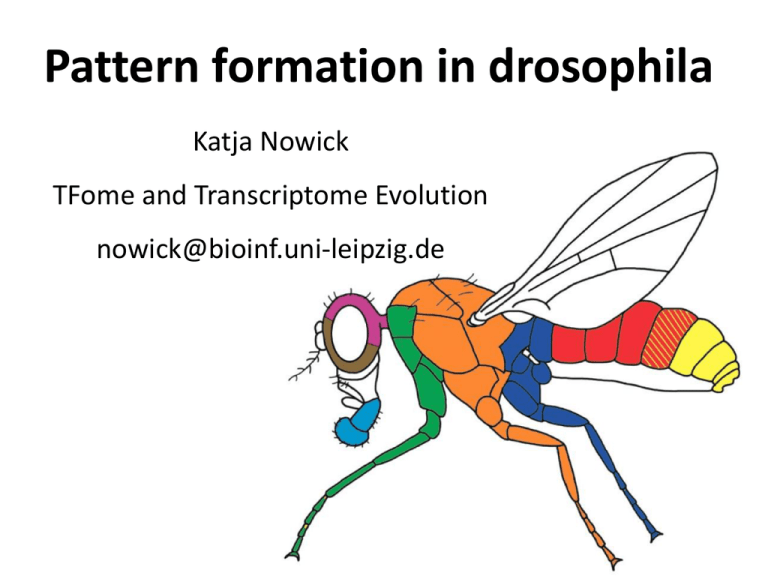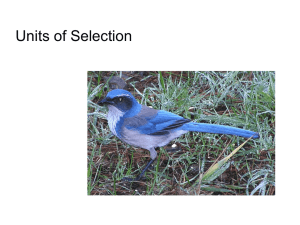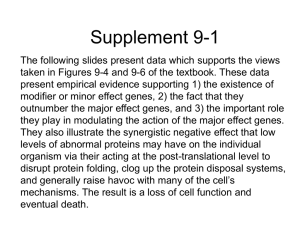hunchback
advertisement

Pattern formation in drosophila Katja Nowick TFome and Transcriptome Evolution nowick@bioinf.uni-leipzig.de Single cell multicellular organism Drosophila development embryogenesis 3h Fertilized egg 5h Adult fly 12d 24h Larva = embryo metamorphosis Early steps of embryogenesis anterior Fertilized egg Nuclei divide but no cell division Syncytium Nuclei migrate to periphery, Further nuclei divisions Synctial blastoderm Membranes form between nuclei Cellular blastoderm Later steps of development 5-6 hours Grooves form at surface of embryo parasegments 9-10 hours Grooves get deeper and move Centers of parasegments are now boundaries between segments T-segments form the thorax (3 T segments) A-segments form the abdomen (8 A segments) Drosophila embryogenesis http://www.youtube.com/watch?v=ymRYxFYLsZ4&feature=relmfu http://www.youtube.com/watch?v=Lb6TJzTLg_E&feature=related Later steps of development 5-6 hours Grooves form at surface of embryo parasegments 9-10 hours Grooves get deeper and move Centers of parasegments are now boundaries between segments T-segments form the thorax (3 T segments) A-segments form the abdomen (8 A segments) Early steps of embryogenesis - Molecular processes Effect of mutations Several adjacent segments missing e.g. no head, no tail Even-numbered or odd-numbered segments missing Only half the number of segments Either anterior or posterior part of a segment missing Cascade of three types of genes: Gap genes Pair-rule genes Segment polarity genes Many developmental genes code for transcription factors (TFs) Cascade of three types of genes: Gap genes Pair-rule genes Segment polarity genes TF Promoter Gene TFs: code for proteins that regulate the expression of other genes activate or repress other genes TFs regulate expression of other genes Promoter Gene TFs: code for proteins that regulate the expression of other genes activate or repress other genes many TFs interact to start/stop transcription of a target Transcription factors (TFs) ~ 1500 TFs in human genome Tubby Structural AF-4 Dwarfin ZNF ZNF AP-2 Paired Box 762 TEA Trp cluster Β-Scaffold NHR FOX Pocket domain GCM HOX HOX T-Box BHLH BHLH 117 BZip 199 E2F Other Jumonji Bromodomain Heat shock RFX Methyl-CpG-binding Modified after Messina et al., 2004 Gap genes Gap genes Pair-rule genes Segment polarity genes hunchback kruppel knirps giant hunchback ˧ ˧ ˧ kruppel knirps giant Regulation of gap genes Network: hunchback ˧ ˧ ˧ kruppel knirps giant Ⱶ Ⱶ tailless huckebein Pair-rule genes Gap genes Pair-rule genes Segment polarity genes Regulation of pair-rule gene eve eve = even-skipped eve expression is controlled separately in each stripe using different binding sites in eve promoter Regulation of pair-rule gene ftz ftz = fushi-tarazu ftz mRNA is region-specifically degraded Regulation of segment polarity genes Gap genes Pair-rule genes Segment polarity genes Fertilized egg Nuclei divide but no cell division Syncytium Nuclei migrate to periphery, Further nuclei divisions Synctial blastoderm Membranes form between nuclei Cellular blastoderm Are expressed in 14 stripes Regulation of segment polarity gene engrailed Gap genes Pair-rule genes Segment polarity genes 7 stripes 14 stripes engrailed expressed in every segment in the posterior (but not anterior) compartment Refinement of the seven stripes engrailed is expressed in every segment in the posterior compartment engrailed induces hedgehog hedgehog binds to patched receptor in neighbor cells activation of wingless in neighbor cells wingless stabilizes engrailed expression wingless also activates naked cuticle and the receptor frizzled in adjacent rows, which inhibits engrailed By receptors and secreted proteins cell-cell interactions Later steps of development 5-6 hours Grooves form at surface of embryo parasegments 9-10 hours Grooves get deeper and move Centers of parasegments are now boundaries between segments T-segments form the thorax (3 T segments) A-segments form the abdomen (8 A segments) Homeotic genes Segmentation genes homeotic selector genes Responsible for unique differentiation of each segment by modifying cell fates Most are TFs, many contain a homeobox (HOX genes) Order of genes on chromosome reflects about the spatial distribution of their expression Homeotic genes in fly and mouse Evolutionarily conserved processes Intermediate summary Fertilized egg Nuclei divide but no cell division Syncytium Nuclei migrate to periphery, Further nuclei divisions Synctial blastoderm Membranes form between nuclei Cellular blastoderm But: How does the location of gap genes determined? Maternal genes aka Maternal effect genes ~30 different genes Are expressed prior to fertilization RNA is already present in the unfertilized egg in the ovary Fertilization RNA gets translated Distribution of maternal RNA in the egg: Uniformly for most genes, e.g. hunchback Few exceptions: e.g. bicoid, nanos Protein diffuses from point of RNA position and creates a gradient Create the first asymmetry in the early embryo Maternal genes Maternal genes define 3 axes Anterior system: development of the head and thorax maternal RNA of bicoid is at the anterior end of the egg bicoid functions as a TF, controls expression of hunchback (and probably also other segmentation and homeotic genes) Posterior system: development of the abdominal segments Controlled by localization of maternal RNA of nanos at the posterior end of the egg nanos causes localized repression of hunchback (via control of translation of the mRNA) Terminal system: development of the specialized structures at the unsegmented ends of the egg (the acron at the head, and the telson at the tail) localized activation of the transmembrane receptor torso Dorsal-ventral system: dorso-ventral development transmembrane receptor Toll receives signals from a follicle cell on the ventral side of the egg leads to a gradient of localization of the TF dorsal Anterior-Posterior axis bicoid bicoid hunchback nanos nanos ˧ hunchback Anterior-Posterior axis Effect of mutations in anterior-posterior axis determination: Weaker gradient anterior part of the embryo looks more posterior-like Stronger gradient anterior structures extend further posterior Unfunctional bicoid: head and thoracic structures are converted to the abdomen making the embryo with posterior structures on both ends, a lethal phenotype Summary Maternal Gap Pair-rule Segment polarity Homeotic genes genes genes genes genes General concepts of pattern formation: Defining axes and establishing gradients Gradients act as signals, cells sense them and respond to them Information in biology is quantitative! Location of the nucleus/cell determines its fate Network/hierachy of TFs defines domains in the embryo (spatial-temporal regulation of gene expression) Cell-cell communication refines the domains Final note 1995 Nobel Prize for Physiology or Medicine awarded for studies on the genetic control of early embryonic development to Christiane Nüsslein-Volhard, Edward B. Lewis and Eric Wieschaus http://www.youtube.com/watch?v=Ncxs21KEj0g&feature=relmfu









